JEE Advanced 2023 is one of the most prestigious engineering entrance exams in India, attracting thousands of aspiring engineers every year. The competition is intense and it is essential for students to be thoroughly prepared for the exam. A crucial aspect of preparing for JEE Advanced 2023 is having a comprehensive understanding of the syllabus. The syllabus for JEE Advanced 2023 will consist of subjects such as Physics, Chemistry, and Mathematics. To give students the best chance of success, it is important to be familiar with the JEE Advanced 2023 syllabus and understand what topics will be covered in the examination. This article will provide an overview of the JEE Advanced 2023 syllabus, including the subjects covered and the topics that will be tested.
Physics
1. General:
- Units and dimensions, dimensional analysis; least count, significant figures; Methods of measurement and error analysis for physical quantities pertaining to the following experiments: Experiments based on using Vernier calipers and screw gauge (micrometer), Determination of g using simple pendulum, Young’s modulus - elasticity of the material Surface tension of water by capillary rise and effect of detergents.
- Specific heat of a liquid using calorimeter, focal length of a concave mirror and a convex lens using u-v method, Speed of sound using resonance column, Verification of Ohm’s law using voltmeter and ammeter, and specific resistance of the material of a wire using meter bridge and post office box.
2. Mechanics:
- Kinematics in one and two dimensions (Cartesian coordinates only), projectiles; Uniform circular motion; Relative velocity. Newton’s laws of motion; Inertial and uniformly accelerated frames of reference; Static and dynamic friction; Kinetic and potential energy; Work and power; Conservation of linear momentum and mechanical energy. Systems of particles; Centre of mass and its motion; Impulse; Elastic and inelastic collisions.
- Rigid body, moment of inertia, parallel and perpendicular axes theorems, moment of inertia of uniform bodies with simple geometrical shapes; Angular momentum; Torque; Conservation of angular momentum; Dynamics of rigid bodies with fixed axis of rotation; Rolling without slipping of rings, cylinders and spheres; Equilibrium of rigid bodies; Collision of point masses with rigid bodies. Forced and damped oscillation (in one dimension), resonance. Linear and angular simple harmonic motions. Hooke’s law, Young’s modulus.
- Law of gravitation; Gravitational potential and field; Acceleration due to gravity; Kepler’s law, Geostationary orbits, Motion of planets and satellites in circular orbits; Escape velocity. Pressure in a fluid; Pascal’s law;Buoyancy; Surface energy and surface tension, angle of contact, drops, bubbles and capillary rise. Viscosity (Poiseuille’s equation excluded), Modulus of rigidity and bulk modulus in mechanics. Stoke’s law; Terminal velocity, Streamline flow, equation of continuity, Bernoulli’s theorem and its applications. Wave motion (plane waves only), longitudinal and transverse waves, superposition of waves; Progressive and stationary waves; Vibration of strings and air columns; Resonance; Beats; Speed of sound in gases; Doppler effect (in sound).
3. Thermal Physics:
- Thermal expansion of solids, liquids and gases; Calorimetry, latent heat; Heat conduction in one dimension; Elementary concepts of convection and radiation; Newton’s law of cooling; Ideal gas laws; Specific heats (Cv and Cp for monoatomic and diatomic gases); Isothermal and adiabatic processes, bulk modulus of gases; Equivalence of heat and work; First law of thermodynamics and its applications (only for ideal gases); Second law of thermodynamics, reversible and irreversible processes, Carnot engine and its efficiency; Blackbody radiation: absorptive and emissive powers; Kirchhoff’s law; Wien’s displacement law, Stefan’s law.
4. Electricity and Magnestism:
- Coulomb’s law; Electric field and potential; Electrical potential energy of a system of point charges and of electrical dipoles in a uniform electrostatic field; Electric field lines; Flux of electric field; Gauss’s law and its application in simple cases, such as, to find field due to infinitely long straight wire, uniformly charged infinite plane sheet and uniformly charged thin spherical shell.
- Capacitance; Parallel plate capacitor with and without dielectrics; Capacitors in series and parallel; Energy stored in a capacitor. Electric current; Ohm’s law; Series and parallel arrangements of resistances and cells; Kirchhoff’s laws and simple applications; Heating effect of current. Biot–Savart’s law and Ampere’s law; Magnetic field near a current-carrying straight wire, along the axis of a circular coil and inside a long straight solenoid; Force on a moving charge and on a current-carrying wire in a uniform magnetic field.
- Magnetic moment of a current loop; Effect of a uniform magnetic field on a current loop; Moving coil galvanometer, voltmeter, ammeter and their conversions. Electromagnetic induction: Faraday’s law, Lenz’s law; Self and mutual inductance; RC, LR, LC and LCR(in series) circuits with d.c. and a.c. sources.
5. Electromagtic Waves
- Electromagnetic waves and their characteristics. Electromagnetic spectrum (radio waves, microwaves, infrared, visible, ultraviolet, x-rays, gamma rays) including elementary facts about their uses.
6. Optics
- Rectilinear propagation of light; Reflection and refraction at plane and spherical surfaces; Total internal reflection; Deviation and dispersion of light by a prism; Thin lenses; Combinations of mirrors and thin lenses; Magnification. Wave nature of light: Huygen’s principle, interference limited to Young’s double slit experiment. Diffraction due to a single slit. Polarization of light, plane polarized light; Brewster's law, Polaroids.
7. Modern Physics
- Atomic nucleus; α, β and γ radiations; Law of radioactive decay; Decay constant; Half-life and mean life; Binding energy and its calculation; Fission and fusion processes; Energy calculation in these processes. Photoelectric effect; Bohr’s theory of hydrogen-like atoms; Characteristic and continuous X-rays, Moseley’s law; de Broglie wavelength of matter waves.
Mathematics
1. Sets, Relations and Functions:
- Sets and their representations, different kinds of sets (empty, finite and infinite), algebra of sets, intersection, complement, difference and symmetric difference of sets and their algebraic properties, De-Morgan’s laws on union, intersection, difference (for finite number of sets) and practical problems based on them.
- Cartesian product of finite sets, ordered pair, relations, domain and codomain of relations, equivalence relation
- Function as a special case of relation, functions as mappings, domain, codomain, range of functions, invertible functions, even and odd functions, into, onto and one-to-one functions, special functions (polynomial, trigonometric, exponential, logarithmic, power, absolute value, greatest integer etc.), sum, difference, product and composition of functions.
2. Algebra:
- Algebra of complex numbers, addition, multiplication, conjugation, polar representation, properties of modulus and principal argument, triangle inequality, cube roots of unity, geometric interpretations.
- Statement of fundamental theorem of algebra, Quadratic equations with real coefficients, relations between roots and coefficients, formation of quadratic equations with given roots, symmetric functions of roots.
- Arithmetic and geometric progressions, arithmetic and geometric means, sums of finite arithmetic and geometric progressions, infinite geometric series, sum of the first n natural numbers, sums of squares and cubes of the first n natural numbers.
- Logarithms and their properties, permutations and combinations, binomial theorem for a positive integral index, properties of binomial coefficients.
3. Matrices:
- Matrices as a rectangular array of real numbers, equality of matrices, addition, multiplication by a scalar and product of matrices, transpose of a matrix, elementary row and column transformations, determinant of a square matrix of order up to three, adjoint of a matrix, inverse of a square matrix of order up to three, properties of these matrix operations, diagonal, symmetric and skew-symmetric matrices and their properties, solutions of simultaneous linear equations in two or three variables.
3. Probability and Statistics:
- Random experiment, sample space, different types of events (impossible, simple, compound), addition and multiplication rules of probability, conditional probability, independence of events, total probability, Bayes Theorem, computation of probability of events using permutations and combinations.
- Measure of central tendency and dispersion, mean, median, mode, mean deviation, standard deviation and variance of grouped and ungrouped data, analysis of the frequency distribution with same mean but different variance, random variable, mean and variance of the random variable.
4. Trigonometry:
- Trigonometric functions, their periodicity and graphs, addition and subtraction formulae, formulae involving multiple and sub-multiple angles, general solution of trigonometric equations.
- Inverse trigonometric functions (principal value only) and their elementary properties.
5. Analytical Geometry:
- Analytical Geometry Two dimensions: Cartesian coordinates, distance between two points, section formulae, shift of origin. Equation of a straight line in various forms, angle between two lines, distance of a point from a line; Lines through the point of intersection of two given lines, equation of the bisector of the angle between two lines, concurrency of lines; Centroid, or the centre, incentre and circumcentre of a triangle. Equation of a circle in various forms, equations of tangent, normal and chord. Parametric equations of a circle, intersection of a circle with a straight line or a circle, equation of a circle through the points of intersection of two circles and those of a circle and a straight line. Equations of a parabola, ellipse and hyperbola in standard form, their foci, directrices and eccentricity, parametric equations, equations of tangent and normal. Locus problems.
- Three dimensions: Distance between two points, direction cosines and direction ratios, equation of a straight line in space, skew lines, shortest distance between two lines, equation of a plane, distance of a point from a plane, angle between two lines, angle between two planes, angle between a line and the plane, coplanar lines.
6. Differential Calculus:
- Limit of a function at a real number, continuity of a function, limit and continuity of the sum, difference, product and quotient of two functions, L’Hospital rule of evaluation of limits of functions.
- Continuity of composite functions, intermediate value property of continuous functions. Derivative of a function, derivative of the sum, difference, product and quotient of two functions, chain rule, derivatives of polynomial, rational, trigonometric, inverse trigonometric, exponential and logarithmic functions.
- Tangents and normals, increasing and decreasing functions, derivatives of order two, maximum and minimum values of a function, Rolle’s theorem and Lagrange’s mean value theorem, geometric interpretation of the two theorems, derivatives up to order two of implicit functions, geometric interpretation of derivatives.
7. Integral Calculus:
- Integration as the inverse process of differentiation, indefinite integrals of standard functions, definite integrals as the limit of sums, definite integral and their properties, fundamental theorem of integral calculus.
- Integration by parts, integration by the methods of substitution and partial fractions, application of definite integrals to the determination of areas bounded by simple curves. Formation of ordinary differential equations, solution of homogeneous differential equations of first order and first degree, separation of variables method, linear first order differential equations.
8. Vectors:
- Addition of vectors, scalar multiplication, dot and cross products, scalar and vector triple products, and their geometrical interpretations.
Chemistry
General Topics
- Concept of atoms and molecules; Dalton’s atomic theory; Mole concept; Chemical formulae; Balanced chemical equations; Calculations (based on mole concept and stoichiometry) involving common oxidation-reduction, neutralisation, and displacement reactions; Concentration in terms of mole fraction, molarity, molality and normality.
States of Matter: Gases and Liquids
- Gas laws and ideal gas equation, absolute scale of temperature; Deviation from ideality, van der Waals equation; Kinetic theory of gases, average, root mean square and most probable velocities and their relation with temperature; Law of partial pressures; Diffusion of gases. Intermolecular interactions: types, distance dependence, and their effect on properties; Liquids: vapour pressure, surface tension, viscosity.
Atomic Structure
- Bohr model, spectrum of hydrogen atom; Wave-particle duality, de Broglie hypothesis; Uncertainty principle; Qualitative quantum mechanical picture of hydrogen atom: Energies, quantum numbers, wave function and probability density (plots only), shapes of s, p and d orbitals; Aufbau principle; Pauli’s exclusion principle and Hund’s rule.
Chemical Bonding and Molecular Structure
- Orbital overlap and covalent bond; Hybridisation involving s, p and d orbitals only; Molecular orbital energy diagrams for homonuclear diatomic species (up to Ne2); Hydrogen bond; Polarity in molecules, dipole moment; VSEPR model and shapes of molecules (linear, angular, triangular, square planar, pyramidal, square pyramidal, trigonal bipyramidal, tetrahedral and octahedral).
Chemical Thermodynamics
- Intensive and extensive properties, state functions, First law of thermodynamics; Internal energy, work (pressure-volume only) and heat; Enthalpy, heat capacity, standard state, Hess’s law; Enthalpy of reaction, fusion and vapourization, and lattice enthalpy; Second law of thermodynamics; Entropy; Gibbs energy; Criteria of equilibrium and spontaneity.
Chemical and Ionic Equilibrium
- Law of mass action; Significance of ȟܩ and ȟܩ ٓin chemical equilibrium; Equilibrium constant (Kp and Kc) and reaction quotient, Le Chatelier’s principle (effect of concentration, temperature and pressure); Solubility product and its applications, common ion effect, pH and buffer solutions; Acids and bases (Bronsted and Lewis concepts); Hydrolysis of salts.
Electrochemistry
- Electrochemical cells and cell reactions; Standard electrode potentials; Electrochemical work, Nernst equation; Electrochemical series, emf of galvanic cells; Faraday’s laws of electrolysis; Electrolytic conductance, specific, equivalent and molar conductivity, Kohlrausch’s law; Batteries: Primary and Secondary, fuel cells; Corrosion.
Chemical Kinetics
- Rates of chemical reactions; Order and molecularity of reactions; Rate law, rate constant, half-life; Differential and integrated rate expressions for zero and first order reactions; Temperature dependence of rate constant (Arrhenius equation and activation energy); Catalysis: Homogeneous and heterogeneous, activity and selectivity of solid catalysts, enzyme catalysis and its mechanism.
Solid State
- Classification of solids, crystalline state, seven crystal systems (cell parameters a, b, c, α, β, γ), close packed structure of solids (cubic and hexagonal), packing in fcc, bcc and hcp lattices; Nearest neighbours, ionic radii and radius ratio, point defects.
Solutions
- Henry’s law; Raoult’s law; Ideal solutions; Colligative properties: lowering of vapour pressure, elevation of boiling point, depression of freezing point, and osmotic pressure; van’t Hoff factor.
Surface Chemistry
- Elementary concepts of adsorption: Physisorption and Chemisorption, Freundlich adsorption isotherm; Colloids: types, methods of preparation and general properties; Elementary ideas of emulsions, surfactants and micelles (only definitions and examples).
Classification of Elements and Periodicity in Properties
- Modern periodic law and the present form of periodic table; electronic configuration of elements; periodic trends in atomic radius, ionic radius, ionization enthalpy, electron gain enthalpy, valence, oxidation states, electronegativity, and chemical reactivity.
Hydrogen
- Position of hydrogen in periodic table, occurrence, isotopes, preparation, properties and uses of hydrogen; hydrides – ionic, covalent and interstitial; physical and chemical properties of water, heavy water; hydrogen peroxide-preparation, reactions, use and structure; hydrogen as a fuel.
s-Block Elements
- Alkali and alkaline earth metals-reactivity towards air, water, dihydrogen, halogens, acids; their reducing nature including solutions in liquid ammonia; uses of these elements; general characteristics of their oxides, hydroxides, halides, salts of oxoacids; anomalous behaviour of lithium and beryllium; preparation, properties, and uses of compounds of sodium (sodium carbonate, sodium chloride, sodium hydroxide, sodium hydrogen carbonate) and calcium (calcium oxide, calcium hydroxide, calcium carbonate, calcium sulphate).
p-Block Elements
- Oxidation state and trends in chemical reactivity of elements of groups 13-17; anomalous properties of boron, carbon, nitrogen, oxygen, and fluorine with respect to other elements in their respective groups.
Group 13: Reactivity towards acids, alkalis, and halogens; preparation, properties, and uses of borax, orthoboric acid, diborane, boron trifluoride, aluminium chloride, and alums; uses of boron and aluminium. - Group 14: Reactivity towards water and halogen; allotropes of carbon and uses of carbon; preparation, properties, and uses of carbon monoxide, carbon dioxide, silicon dioxide, silicones, silicates, zeolites.
- Group 15: Reactivity towards hydrogen, oxygen, and halogen; allotropes of phosphorous; preparation, properties, and uses of dinitrogen, ammonia, nitric acid, phosphine, phosphorus trichloride, phosphorus pentachloride; oxides of nitrogen and oxoacids of phosphorus.
- Group 16: Reactivity towards hydrogen, oxygen, and halogen; simple oxides; allotropes of sulfur; preparation/manufacture, properties, and uses of dioxygen, ozone, sulfur dioxide, sulfuric acid; oxoacids of sulfur.
- Group 17: Reactivity towards hydrogen, oxygen, and metals; preparation/manufacture, properties, and uses of chlorine, hydrogen chloride and interhalogen compounds; oxoacids of halogens, bleaching powder.
- Group 18: Chemical properties and uses; compounds of xenon with fluorine and oxygen.
d-Block Elements
- Oxidation states and their stability; standard electrode potentials; interstitial compounds; alloys; catalytic properties; applications; preparation, structure, and reactions of oxoanions of chromium and manganese.
f-Block Elements
- Lanthanoid and actinoid contractions; oxidation states; general characteristics.
Coordination Compounds
- Werner’s theory; Nomenclature, cis-trans and ionization isomerism, hybridization and geometries (linear, tetrahedral, square planar and octahedral) of mononuclear coordination compounds; Bonding [VBT and CFT (octahedral and tetrahedral fields)]; Magnetic properties (spin-only) and colour of 3d-series coordination compounds; Ligands and spectrochemical series; Stability; Importance and applications; Metal carbonyls.
Isolation of Metals
- Metal ores and their concentration; extraction of crude metal from concentrated ores: thermodynamic (iron, copper, zinc) and electrochemical (aluminium) principles of metallurgy; cyanide process (silver and gold); refining.
Principles of Qualitative Analysis
- Groups I to V (only Ag+, Hg2+, Cu2+, Pb2+, Fe3+, Cr3+, Al3+, Ca2+, Ba2+, Zn2+, Mn2+ and Mg2+); Nitrate, halides (excluding fluoride), carbonate and bicarbonate, sulphate and sulphide.
Environmental Chemistry
- Atmospheric pollution; water pollution; soil pollution; industrial waste; strategies to control environmental pollution; green chemistry.
Basic Principles of Organic Chemistry
- Hybridisation of carbon; σ and π-bonds; Shapes of simple organic molecules; aromaticity; Structural and geometrical isomerism; Stereoisomers and stereochemical relationship (enantiomers, diastereomers, meso) of compounds containing only up to two asymmetric centres (R,S and E,Z configurations excluded); Determination of empirical and molecular formulae of simple compounds by combustion method only; IUPAC nomenclature of organic molecules (hydrocarbons, including simple cyclic hydrocarbons and their mono-functional and bi-functional derivatives only); Hydrogen bonding effects; Inductive, Resonance and Hyperconjugative effects; Acidity and basicity of organic compounds; Reactive intermediates produced during homolytic and heterolytic bond cleavage; Formation, structure and stability of carbocations, carbanions and free radicals.
Alkanes
- Homologous series; Physical properties (melting points, boiling points and density) and effect of branching on them; Conformations of ethane and butane (Newman projections only); Preparation from alkyl halides and aliphatic carboxylic acids; Reactions: combustion, halogenation (including allylic and benzylic halogenation) and oxidation.
Alkenes and Alkynes
- Physical properties (boiling points, density and dipole moments); Preparation by elimination reactions; Acid catalysed hydration (excluding the stereochemistry of addition and elimination); Metal acetylides; Reactions of alkenes with KMnO4 and ozone; Reduction of alkenes and alkynes; Electrophilic addition reactions of alkenes with X2, HX, HOX, (X=halogen); Effect of peroxide on addition reactions; cyclic polymerization reaction of alkynes.
Benzene
- Structure; Electrophilic substitution reactions: halogenation, nitration, sulphonation, Friedel Crafts alkylation and acylation; Effect of directing groups (monosubstituted benzene) in these reactions.
Phenols
- Physical properties; Preparation, Electrophilic substitution reactions of phenol (halogenation, nitration, sulphonation); Reimer-Tiemann reaction, Kolbe reaction; Esterification; Etherification; Aspirin synthesis; Oxidation and reduction reactions of phenol.
Alkyl Halides
- Rearrangement reactions of alkyl carbocation; Grignard reactions; Nucleophilic substitution reactions and their stereochemical aspects.
Alcohols
- Physical properties; Reactions: esterification, dehydration (formation of alkenes and ethers); Reactions with: sodium, phosphorus halides, ZnCl2/concentrated HCl, thionyl chloride; Conversion of alcohols into aldehydes, ketones and carboxylic acids.
Ethers
- Preparation by Williamson’s synthesis; C-O bond cleavage reactions.
Aldehydes and Ketones
- Preparation of: aldehydes and ketones from acid chlorides and nitriles; aldehydes from esters; benzaldehyde from toluene and benzene; Reactions: oxidation, reduction, oxime and hydrazone formation; Aldol condensation, Cannizzaro reaction; Haloform reaction; Nucleophilic addition reaction with RMgX, NaHSO3, HCN, alcohol, amine.
Carboxylic Acids
- Physical properties; Preparation: from nitriles, Grignard reagents, hydrolysis of esters and amides; Preparation of benzoic acid from alkylbenzenes; Reactions: reduction, halogenation, formation of esters, acid chlorides and amides.
Amines
- Preparation from nitro compounds, nitriles and amides; Reactions: Hoffmann bromamide degradation, Gabriel phthalimide synthesis; Reaction with nitrous acid, Azo coupling reaction of diazonium salts of aromatic amines; Sandmeyer and related reactions of diazonium salts; Carbylamine reaction, Hinsberg test, Alkylation and acylation reactions.
Haloarenes
- Reactions: Fittig, Wurtz-Fittig; Nucleophilic aromatic substitution in haloarenes and substituted haloarenes (excluding benzyne mechanism and cine substitution).
Biomolecules
- Carbohydrates: Classification; Mono- and di-saccharides (glucose and sucrose); Oxidation; Reduction; Glycoside formation and hydrolysis of disaccharides (sucrose, maltose, lactose); Anomers.
- Proteins: Amino acids; Peptide linkage; Structure of peptides (primary and secondary); Types of proteins (fibrous and globular).
- Nucleic acids: Chemical composition and structure of DNA and RNA.
Polymers
- Types of polymerization (addition, condensation); Homo and copolymers; Natural rubber; Cellulose; Nylon; Teflon; Bakelite; PVC; Bio-degradable polymers; Applications of polymers.
Chemistry in Everyday Life
- Drug-target interaction; Therapeutic action, and examples (excluding structures), of antacids, antihistamines, tranquilizers, analgesics, antimicrobials, and antifertility drugs; Artificial sweeteners (names only); Soaps, detergents, and cleansing action.
Practical Organic Chemistry
- Detection of elements (N, S, halogens); Detection and identification of the following functional groups: hydroxyl (alcoholic and phenolic), carbonyl (aldehyde and ketone), carboxyl, amino and nitro.
EduRev has courses with complete syllabus in the most structured manner so that you can prepare for your JEE Advanced Exam in the best possible way.
Important Topics from JEE Advanced 2023 Syllabus
It is crucial to study all the chapters and topics listed in the JEE Advanced 2023 syllabus, but some carry more significance in the exam and should not be neglected. These are considered crucial or make-or-break chapters for JEE Advanced.
JEE Advanced important topics in Physics
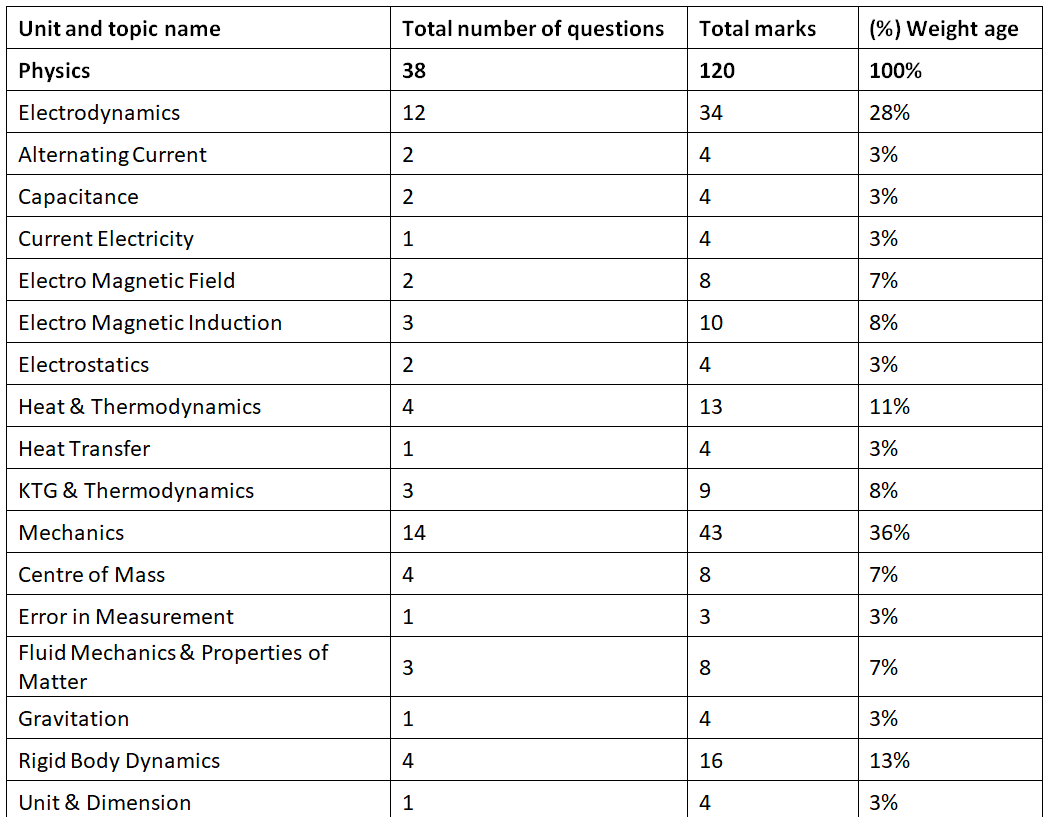

JEE Advanced important topics in Chemistry
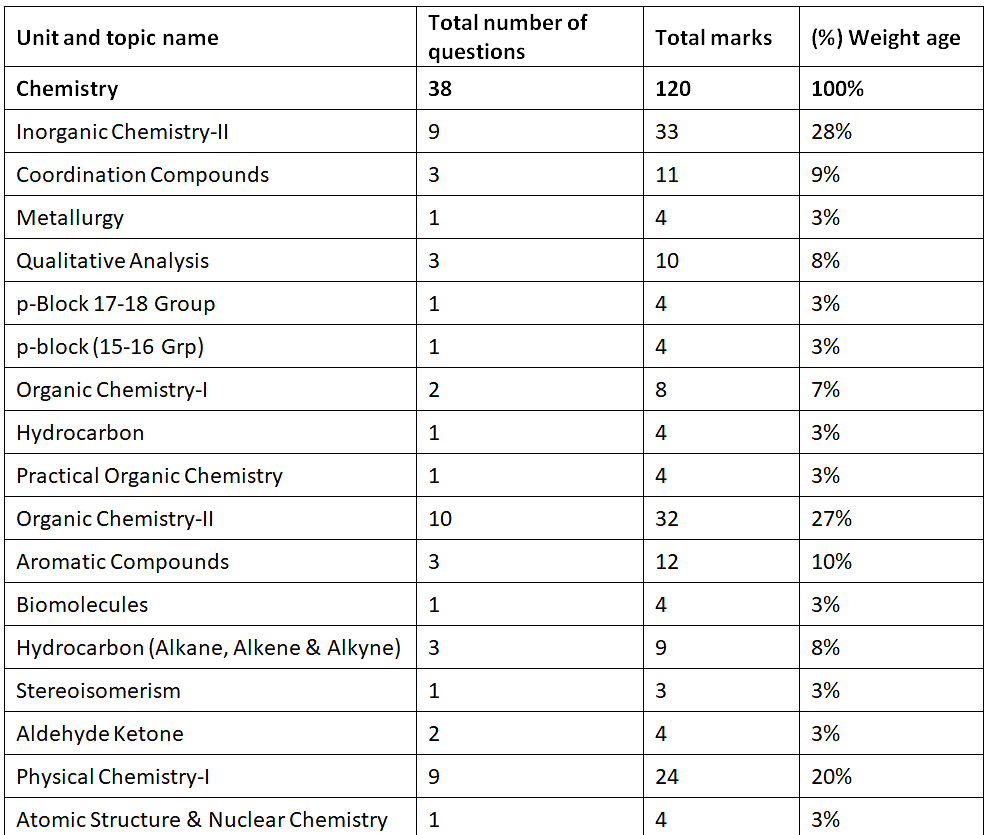
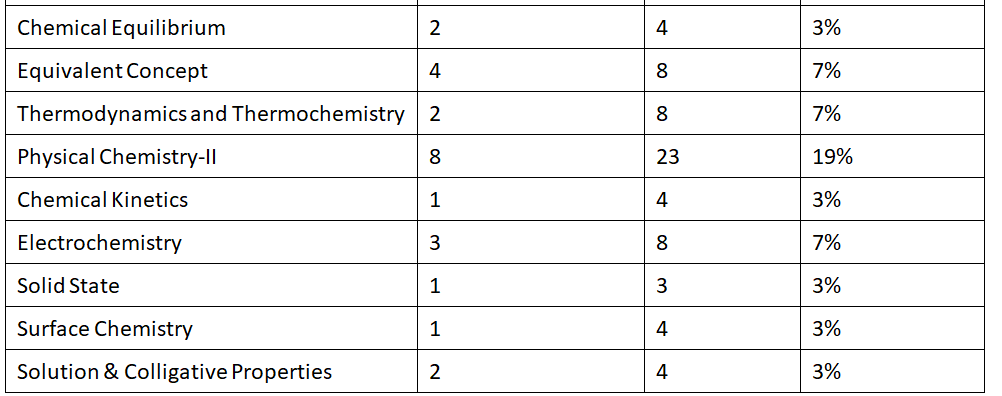
JEE Advanced important topics in Maths
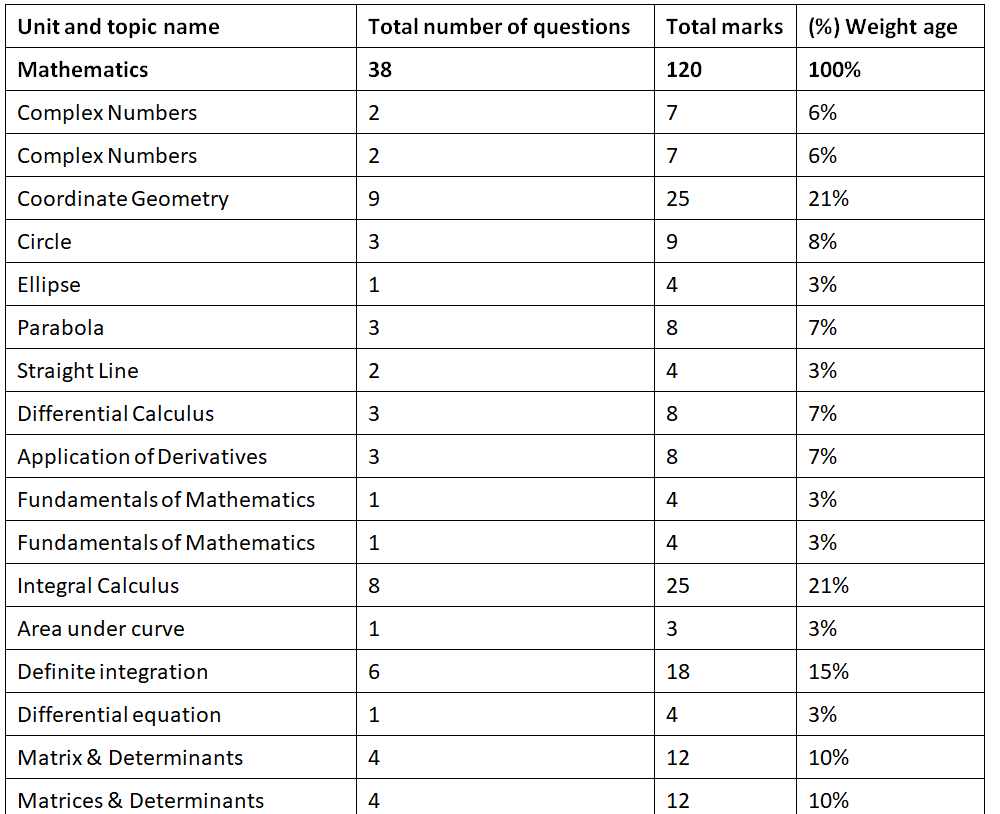
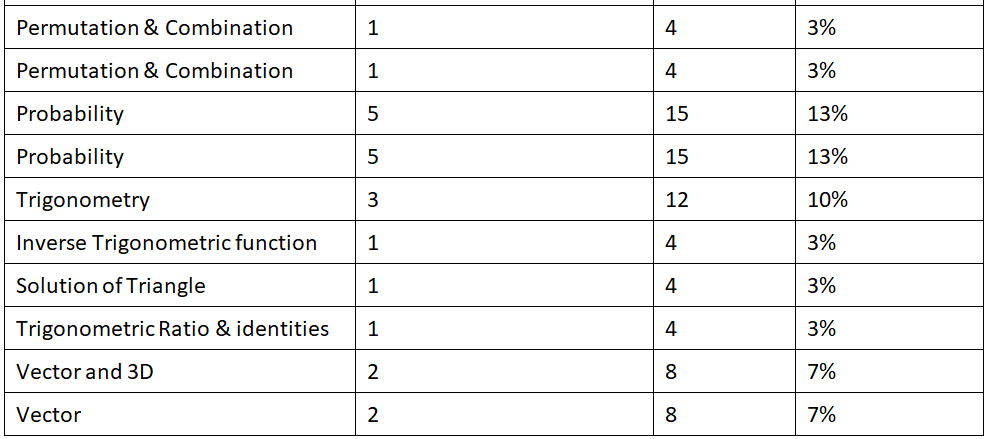
Benefits of knowing the complete syllabus of JEE Advanced 2023
- Organizes Study: Going through the JEE Advanced syllabus once helps students to eliminate uncertainty about skipping or covering subjects. It allows for effective time management and organization of study time.
- Mark Distribution: The syllabus provides information on the marks assigned to each chapter in Chemistry, Physics, and Mathematics. This allows students to plan their studies more effectively by prioritizing important chapters.
- Examination Blueprint: The syllabus serves as a blueprint for the JEE advanced exam, including all topics and subtopics to be covered. Studying the syllabus eliminates uncertainty about what to study and what to avoid.
- Good Grades: Understanding the syllabus provides an overview of the JEE advanced exam, allowing students to plan and study better, leading to improved grades.
- Saves Time: By following the tested syllabus, students can save time and avoid wasting time on subjects that may not appear in the exam.
- Takes Charge of Learning: Understanding the syllabus is the first and most important step in preparing for JEE advanced. It gives students control over their learning and helps them to familiarize themselves with the subjects covered.
- Familiarizes with Examination Paper: Knowing the syllabus and exam format helps students understand how the exam paper will be structured. This eliminates uncertainty and helps students familiarize themselves with the question paper, allowing them to predict the type of questions that may appear in the exam.
How to prepare for JEE with EduRev Infinity
EduRev Infinity Package for JEE includes
- Subject-wise Courses: Courses for all the 3 subjects: Physics, Chemistry, and Mathematics. Each course offers topic-wise video lectures, detailed notes & online tests for each topic.
- Guidance book and Revision Notes: With the EduRev Infinity access, you can have access to the NCERT Exemplar and JEE Revision Notes so that you can save time and effort in finding the best learning resources.
- Solutions for Reference Books: EduRev’s Infinity package for JEE also includes solutions for reference books like HC Verma, DC Pandey, and Irodov.
- Discussion forum: Along with the learning, you can get your doubts solved with the help of the discussion forum; the largest community of teachers and students to help you all the time.
- Previous Year Question Papers: You will get solved previous year question papers for Physics, Chemistry, and Mathematics, as well as topic-wise solved PYQs for JEE Mains and Advance which have appeared in the last 35 years.
- Daily Practice Problems (DPPs): To get a better understanding of different types of questions, you can refer to the Daily Practice Problems for JEE Mains and Advanced available in EduRev’s Infinity package.
- Mock Test Series for JEE preparation: EduRev provides Mock Test Series for JEE Mains and Advanced, which includes over 160 mock tests including part-test which helps you prepare particular topics better.
- Test Analysis: You will get a comprehensive analysis of the tests you attempted, with in-depth solutions to each question. You will also gain insight into your performance relative to other test-takers, with an All India Rank, to identify your strengths and weaknesses.

- Revision Material: EduRev offers comprehensive revision notes, formula sheets, mind maps, and PPTs for quick and easy last-minute revisions.
- Crash course: If you have limited time, EduRev also provides a crash course for JEE preparation with detailed and structured video lectures.
Best Books for JEE Advanced 2023
For students aspiring to take the JEE examination, success requires a combination of a positive mindset, hard work, and dedication. In addition to this, it is crucial for learners to use the right study tools to aid in their preparation. With numerous JEE books available in the market, it is important to choose the right one. Selecting the appropriate book can be challenging, but utilizing the right books can greatly benefit a student's understanding of the subjects. Good books provide students with in-depth knowledge, instead of just a superficial understanding, helping them grasp complex topics with ease. Here is list of some best books for JEE Advanced which you must consider reading.
Books for Physics
- NCERT Textbooks
- Fundamentals of Physics by Halliday, Resnick and Walker
- Concepts of Physics Vol I & II by H.C. Verma (Highly Suggested)
- Problems in General Physics by, I.E. Irodov
- Problems in Physics by S.S. Krotov
- IIT Physics by D.C. Pandey
Books for Chemistry
- Textbooks published by NCERT
- Organic Chemistry – Peter Sykes
- Organic Chemistry – O. P. Tandon
- Organic Chemistry – M. S. Chauhan
- Organic Chemistry – Morrison and Boyd (This book goes into great depth on a variety of issues. If there is a time limitation, be sure to emphasise what is crucial before proceeding.)
- Physical Chemistry – O. P. Tandon
- Concise Inorganic Chemistry – J. D. Lee
Books for Mathematics
- S.L. Loney’s Trigonometry and Geometry: Plane Trigonometry Part 1
- R.D. Sharma’s Maths XI and XII
- R.D. Sharma’s Objective Mathematics for JEE Main and Advanced & Other Engineering Entrance Exams
- Algebra: Hall and Knight’s Higher Algebra
- Co-ordinate Geometry: S.L. Loney’s Plane Co-ordinate Geometry
- Das Gupta’s Differential Calculus.
- I.A. Maron’s Calculus: – Problems in Calculus with One Variable
Frequently Asked Questions (FAQs) based on JEE Advanced 2023 Syllabus
Does JEE Advanced have out of syllabus questions?
JEE has never gone out of the syllabus. They do give some questions which are out of syllabus but with a neat legal right that they put a comprehension type. So they expect you to understand a new concept which is out of syllabus by reading the comprehension and then the questions asked below.
What type of questions are asked in JEE Advanced?
There are three types of questions in the JEE exam, i.e., Numerical questions, MCQs, and Integer questions.
Which is the easiest subject in JEE Advanced?
Among the three subjects, Chemistry is usually the easiest subject to score high marks.Students find Mathematics the most difficult, while Physics is sandwiched between the two.
How much percentage in 12th is required for IIT?
For admission into IITs, NITs, CFTIs the score that candidates have secured in their class 12 board exam will be taken into account. In this, candidates should have passed their exam with a minimum of 75 percent and for SC/ST it should be 65 percent.
Can I crack JEE ADV in 10 days?
Of course, it is possible to secure a good rank in IIT JEE with the last 10 days' preparation. At this time, you just need to focus on solving previous years' questions and mock tests to assess your performance and practise more and more these days.















